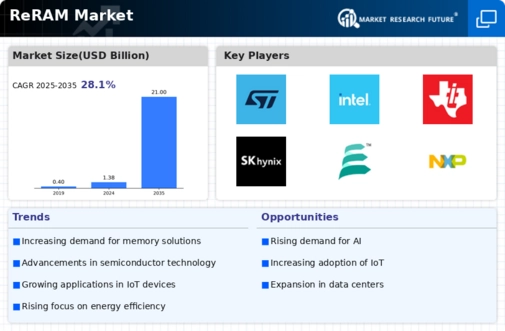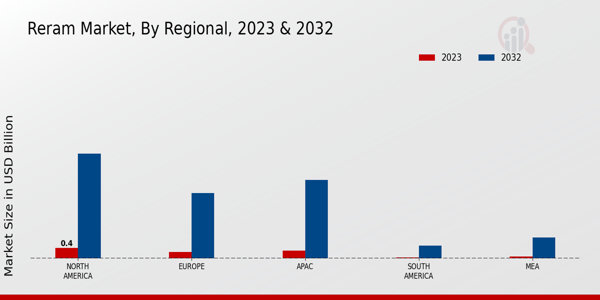Market Growth Projections
The Global ReRAM Market Industry is poised for remarkable growth, with projections indicating a market value of 1.38 USD Billion in 2024 and an anticipated rise to 21.0 USD Billion by 2035. This trajectory suggests a compound annual growth rate of 28.06% from 2025 to 2035, reflecting the increasing adoption of ReRAM technology across diverse applications. The growth is driven by factors such as rising demand for memory solutions, technological advancements, and the expanding role of ReRAM in emerging technologies like IoT and AI. These projections highlight the potential of ReRAM to reshape the memory landscape in the coming years.
Growing Adoption in IoT Devices
The proliferation of Internet of Things (IoT) devices significantly influences the Global ReRAM Market Industry. As more devices become interconnected, the demand for efficient, low-power memory solutions escalates. ReRAM's unique characteristics, such as non-volatility and fast switching speeds, make it particularly suitable for IoT applications, where energy efficiency is critical. This trend is expected to drive substantial growth in the market, with a compound annual growth rate of 28.06% projected from 2025 to 2035. The increasing integration of ReRAM in smart home devices, wearables, and industrial IoT applications underscores its potential in this rapidly evolving sector.
Rising Demand for Memory Solutions
The Global ReRAM Market Industry experiences a surge in demand for advanced memory solutions driven by the increasing need for high-performance computing and data storage. As industries such as artificial intelligence and big data analytics expand, the requirement for faster and more efficient memory technologies becomes paramount. ReRAM, with its potential for higher speed and lower power consumption compared to traditional memory technologies, is well-positioned to meet these demands. In 2024, the market is projected to reach 1.38 USD Billion, reflecting the growing adoption of ReRAM in various applications, including mobile devices and cloud computing.
Support from Government Initiatives
Government initiatives aimed at promoting advanced semiconductor technologies contribute positively to the Global ReRAM Market Industry. Various countries are investing in research and development programs to foster innovation in memory technologies, including ReRAM. These initiatives often include funding for startups and collaborations between academia and industry, which can accelerate the commercialization of ReRAM solutions. As governments recognize the strategic importance of semiconductor technologies for economic growth and national security, the support for ReRAM development is likely to increase, further driving market expansion in the coming years.
Technological Advancements in ReRAM
Technological advancements play a crucial role in propelling the Global ReRAM Market Industry forward. Innovations in materials and fabrication techniques enhance the performance and scalability of ReRAM devices. For instance, the development of new switching materials and improved integration methods allows for smaller, more efficient memory cells. These advancements not only increase the reliability of ReRAM but also reduce production costs, making it a more attractive option for manufacturers. As a result, the market is anticipated to grow significantly, with projections indicating a rise to 21.0 USD Billion by 2035, driven by continuous innovation and research in the field.
Emerging Applications in Artificial Intelligence
The emergence of artificial intelligence applications significantly impacts the Global ReRAM Market Industry. As AI technologies require vast amounts of data processing and storage, the demand for efficient memory solutions like ReRAM is on the rise. ReRAM's ability to provide high-speed data access and low power consumption aligns well with the needs of AI systems, making it an attractive option for developers. This trend is expected to contribute to the market's growth trajectory, with projections indicating a substantial increase in market value, potentially reaching 21.0 USD Billion by 2035 as AI applications continue to proliferate across various sectors.
























Leave a Comment